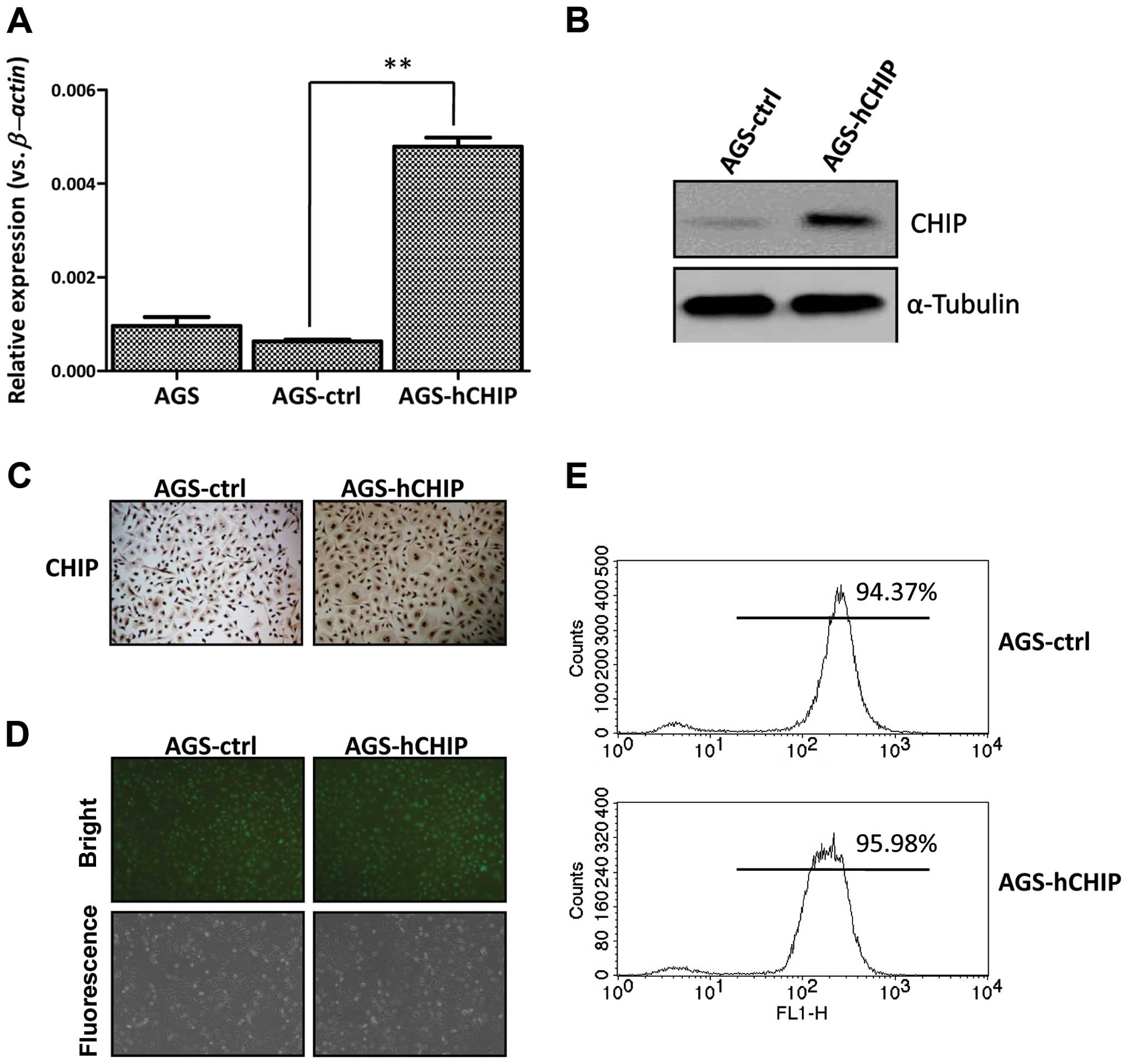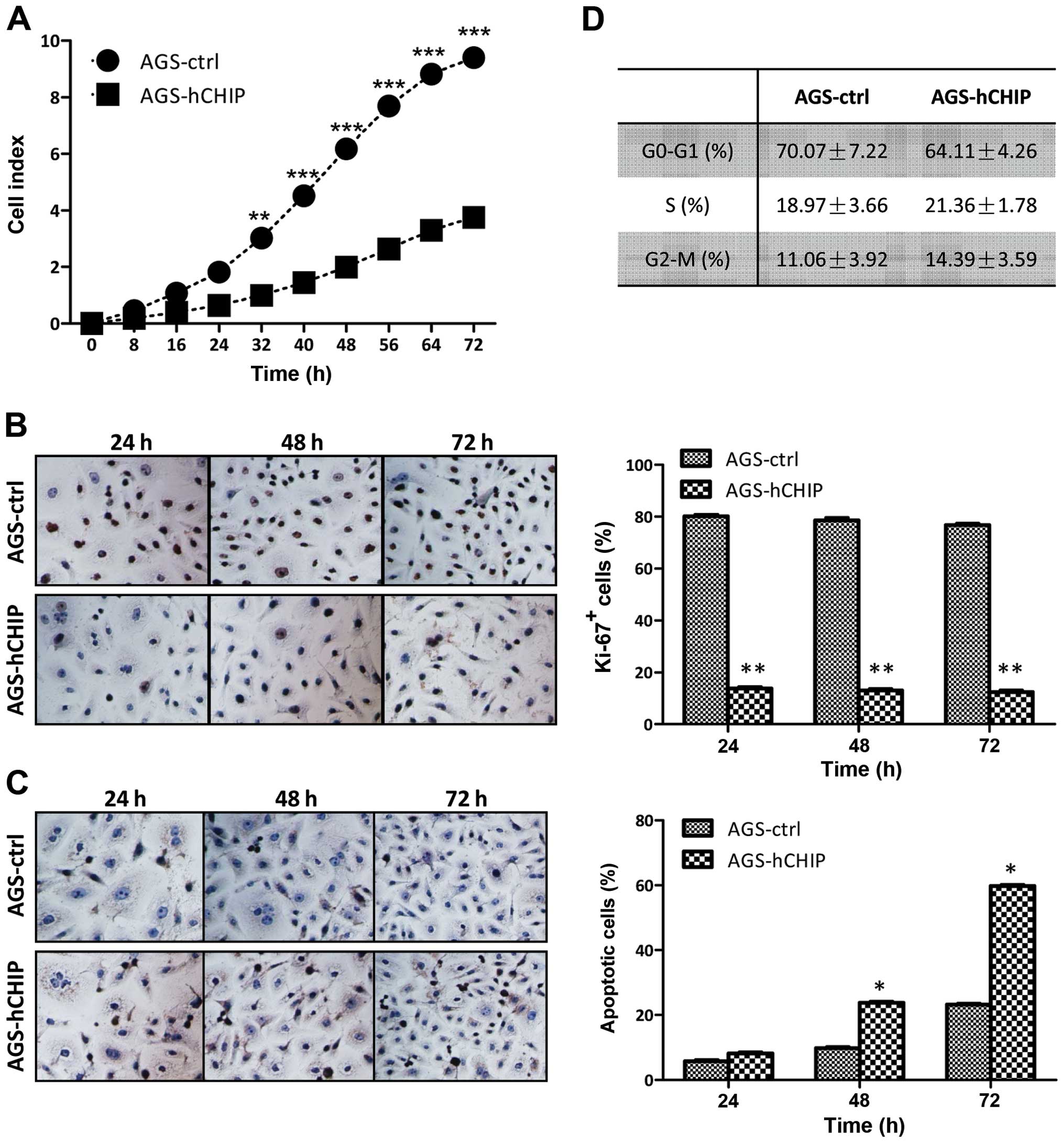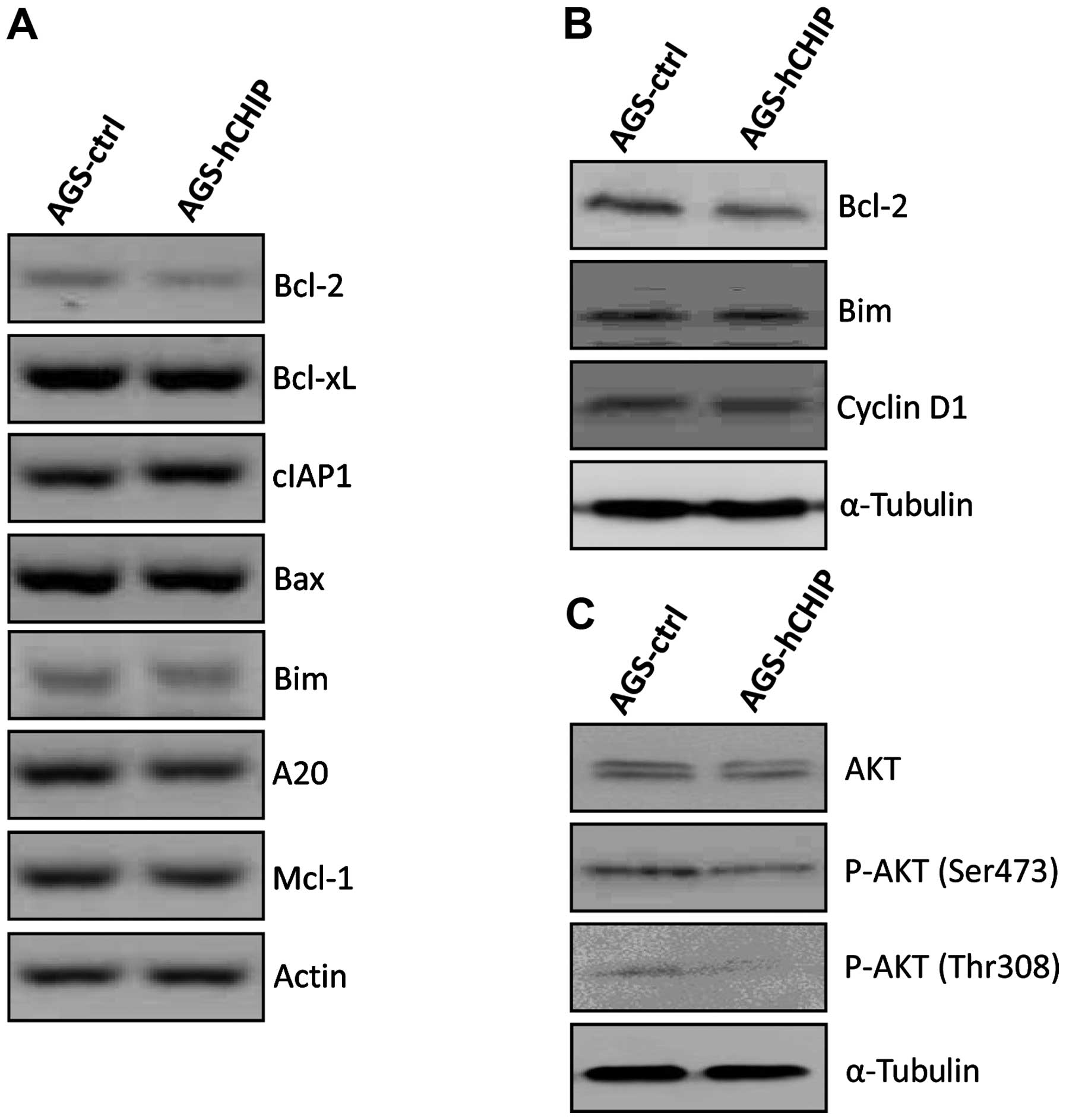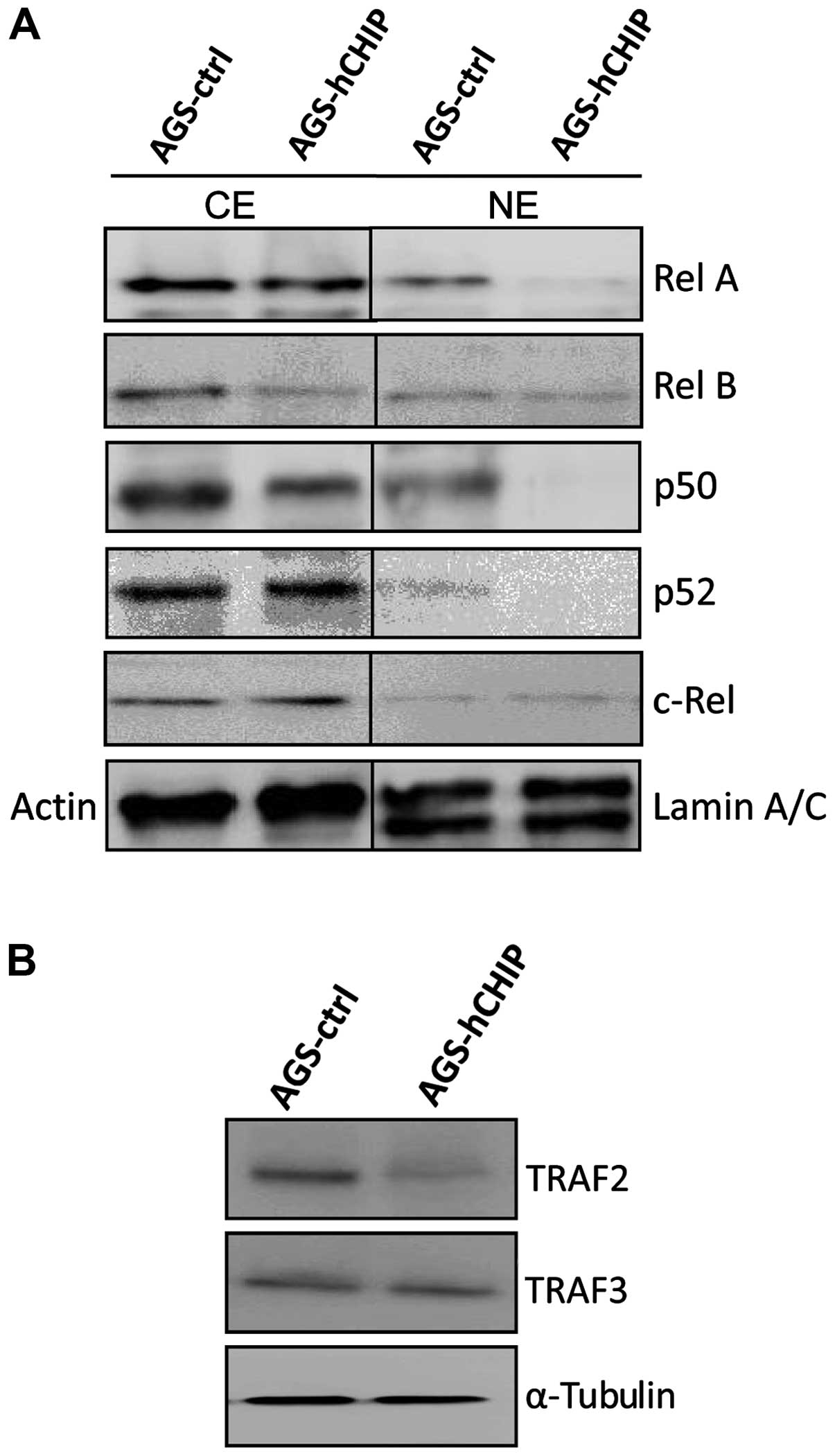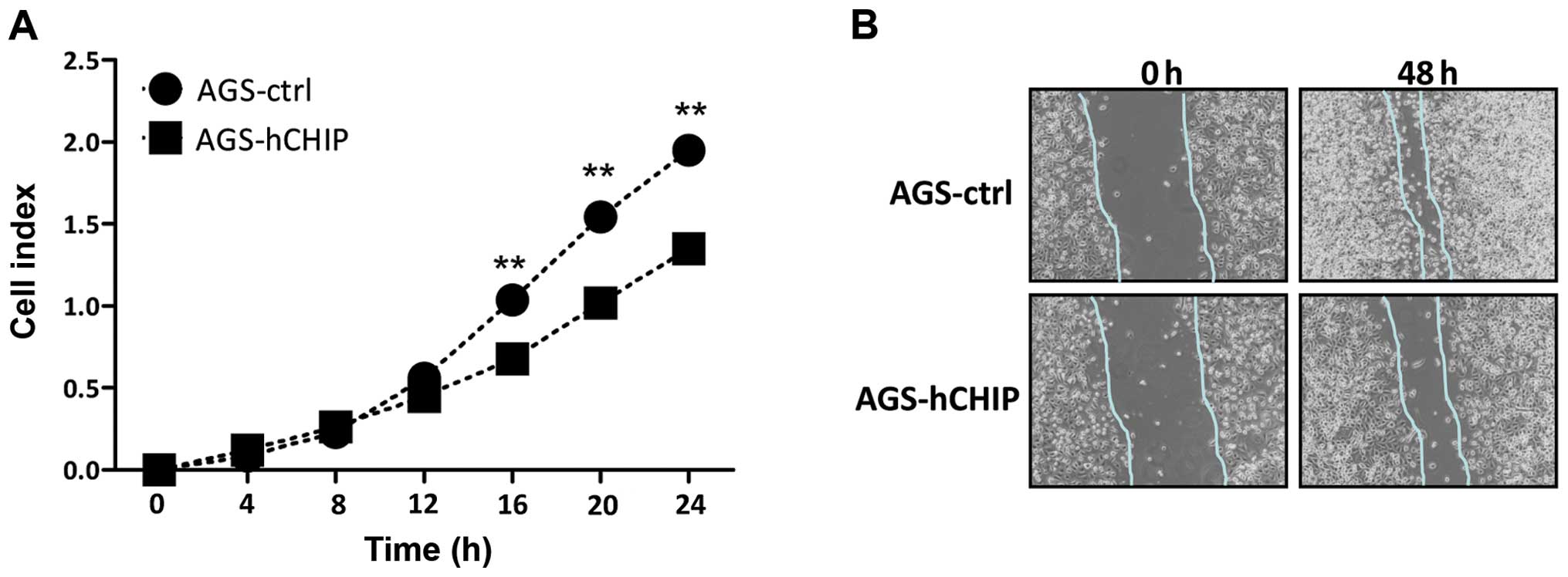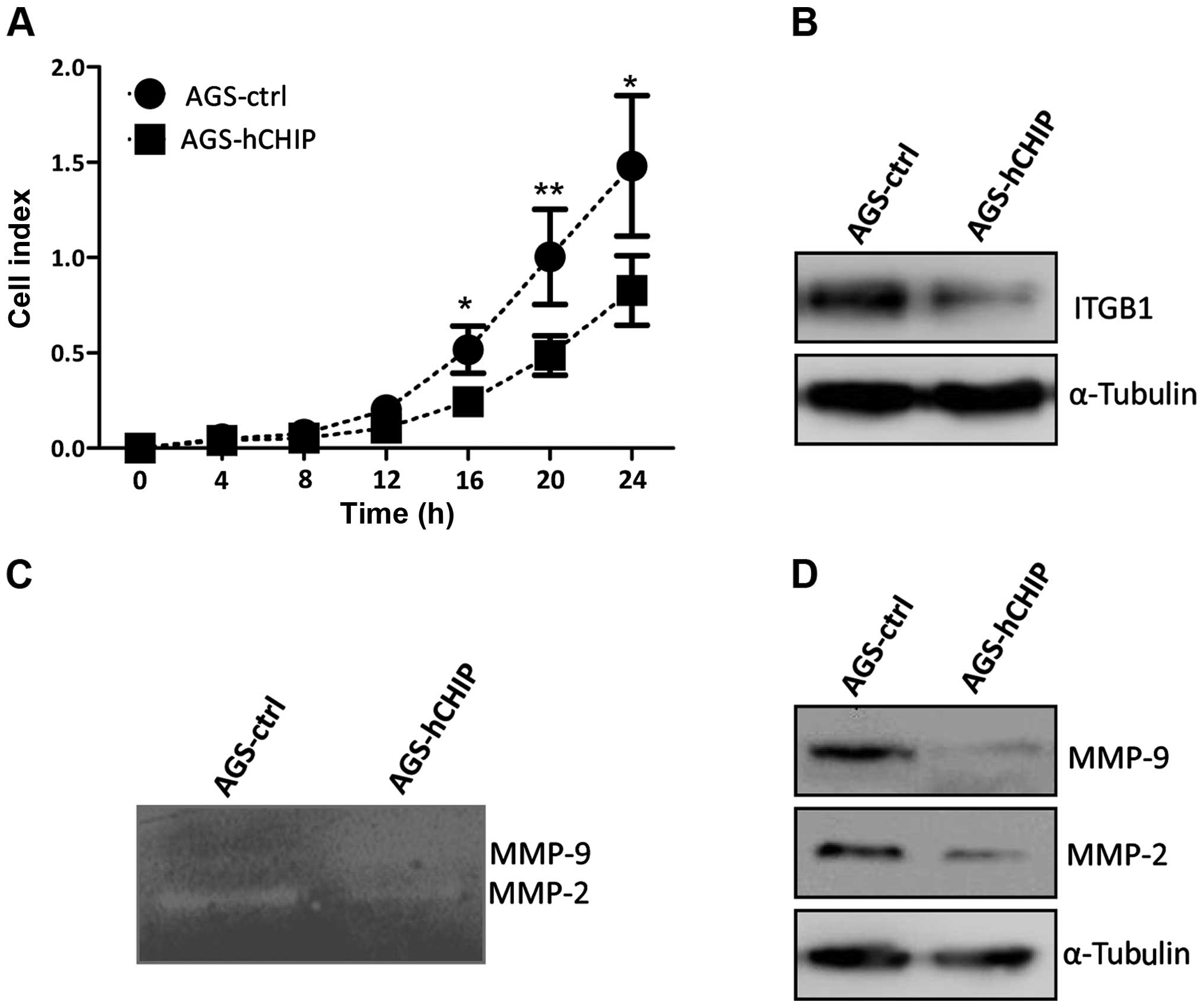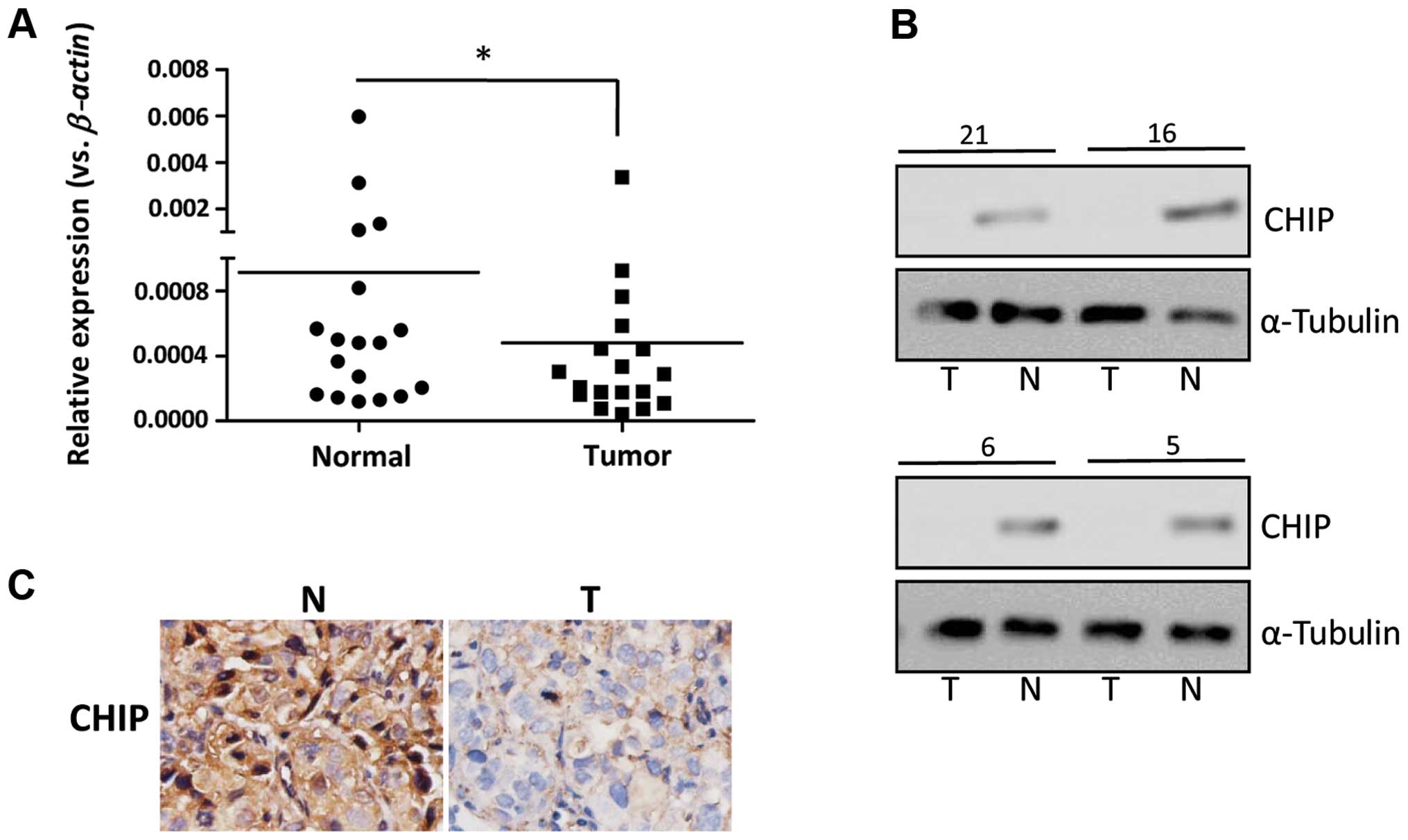The ubiquitin ligase CHIP inactivates NF-κB signaling and impairs the ability of migration and invasion in gastric cancer cells
- Authors:
- Published online on: February 11, 2015 https://doi.org/10.3892/ijo.2015.2893
- Pages: 2096-2106
Abstract
Introduction
Although global statistics show that gastric cancer is the fourth most common cancer in men and the fifth most common cancer in women, the mortality from gastric cancer ranks third to lung and liver cancer (1). Advances in diagnosis and therapeutics have improved long-term survival for early gastric cancer; however, the prognosis of advanced and metastatic gastric cancer is still not satisfactory. A better understanding of the molecular pathologies of metastatic gastric cancer will lead to progress in both diagnostics and treatment.
Metastasis is a critical determinant of cancer morbidity. Tumor cell metastasis is a multiphasic process including cell transformation, growth, angiogenesis, invasion, dissemination and survival in the circulation and cell growth at distant sites from the primary tumor location. Each step requires distinct molecular program regulating the interaction between the tumor cells, the extracellular matrix (ECM) and the cells of the stroma. Molecules participating in these steps can also be considered as potential prognostic factors. Diverse molecular regulators, including adhesion receptor families, receptor tyrosine kinase, cytoskeleton protein, adapters and signaling molecules, are involved in the regulation of migration and invasion to tumor cells (2).
The carboxyl terminus of Hsc-70-interacting protein (CHIP), encoded by the STUB1 gene, was first cloned and characterized in human heart (3). CHIP contains two important domains. The N-terminal domain of CHIP consists of three tetratricopeptide repeat (TPR) domains mediating protein-protein interactions, and a U-box domain at its C-terminus displaying E3 ubiquitin ligase activity (4). CHIP functions in maintaining the protein homeostasis in the cytoplasm by promoting the ubiquitination and depredation of chaperone-bound and misfolded proteins including glucocorticoid receptor (GR), cystic fibrosis transmembrane conductance regulator (CFTR) and mutated superoxide dismutase 1 (SOD1) (5–7). CHIP is also involved in the degradation of multiple oncogenic proteins.
Though the exact function of CHIP in tumorigenesis has not been uncovered, accumulated evidence indicates that CHIP predominantly functions as a tumor suppressor. Several studies indicate that CHIP expression can be considered as an independent prognostic factor for cancer patients including gastric, breast and colorectal cancers (8–10). In human colorectal cancer cells, CHIP inhibits the malignancy possibly through negatively regulating the NF-κB activity (10). In breast cancer cells, CHIP is implicated in the modulation the stability of estrogen receptor (ESRI) and Her-2/neu (ERBB2). CHIP silencing in breast cancer cells results in rapid tumor growth and other malignant phenotypes (11). CHIP overexpression in the MDA-MB-231 breast cancer cells promotes the ubiquitination of TNF receptor-associated factor 2 (TRAF2) and subsequently inactivates the TRAF2-NF-κB signaling (12). In gastric cancer cells, it has been reported that CHIP can degrade the classical NF-κB member RelA/p65 and inhibit the IL-8-induced angiogenesis (13).
However, the role of CHIP in the metastasis of gastric cancer is still poorly understood. In this study, we investigated the functional importance and potential mechanism of CHIP in the migration and invasion in gastric cancer.
Materials and methods
Clinical samples
Gastric cancer tissues were obtained, with written consent, from 164 gastric cancer patients at the Department of General Surgery, the First Affiliated Hospital of Soochow University, from 2008 to 2013. All patients had an accurate pathology diagnosis and underwent surgery without chemotherapy or radiotherapy before operation.
Tissue culture
The human gastric cancer cell line AGS was purchased from American Type Culture Collection (ATCC). All cell lines were cultured in F-12 (Hyclone, HAM’S/F-12) supplemented with 10% fetal bovine serum (FBS), 100 U/ml penicillin, 100 μg/ml streptomycin and 2 mM glutamine. The cells were cultured at 37°C in a humidified atmosphere of 5% CO2.
Transfection
CHIP overexpression vector was constructed based on the MSCV vector containing GFP. Full-length CDS of CHIP was amplified by PCR from human breast tissue and cloned into MSCV-GFP vector (MSCV-GFP-hCHIP). Primer sequences of CHIP are as follows: 5′-AAAAAGATCTGGCGGCATGAAGGGCAAGG-3′ and 5′-GGGAACCTCAGTAGTCCTCCACCC-3′. Phoenix A packaging cells were transfected with MSCV-GFP-hCHIP or control vector (MSCV-GFP) by FuGENE HD (Roche, China). Lentivirus supernatants were used to infect the target cells.
Quantitative real-time PCR (qRT-PCR)
Equivalent amounts of RNA (2 μg) were reverse-transcribed with Superscript M-MLV (Promega, China). Triplicates were performed for all qRT-PCR reactions with a LightCycler 480 System (Roche). Primers for qRT-PCR were designed using Primer-BLAST (PubMed). Primers were synthesized from Invitrogen (China). The housekeeping gene (β-actin) and target genes were reverse transcribed together in a single run. The reaction with 2X LC480 SYBR Green I Master Mix (Roche) was according to the manufacturer’s protocol. For data analysis, a target gene transcript was quantified in comparison to the house keeping gene (β-actin) as a reference.
Western blot analysis
Whole-cell extracts were prepared with RIPA buffer according to standard procedures. Proteins were fractionated on an SDS-PAGE gel and transferred to PVDF membranes. After blocking, membranes were probed with different antibodies (Abs). Membranes were then washed and incubated with an appropriate secondary antibody. Proteins were detected and scanned with the Gel Imaging system (PeiQing, China). Band density was normalized to the α-tubulin, actin or GAPDH reference. Abs against Bcl-2 (sc-7382), Cyclin D1 (sc-20044), TRAF-2 (sc-876), RelA (sc-372), p50 (sc-7178), p100/p52 (sc-3017), RelB (sc-226) and c-Rel (sc-70) were purchased from Santa Cruz Biotechnology. Abs against Bim (#2819), AKT (#4691), p-AKT (Ser473) (#4060), p-AKT (Thr308) (#2965), TRAF-3 (#4729), ITGB1 (#9699), MMP-2 (#4022), MMP-9 (#2270) and CHIP (#2080) were obtained from Cell Signaling Technology. α-tubulin (AJ1034a), actin (AT0001) and GAPDH (#5174) were purchased from Abgent.
Cell growth assay
Cell growth was performed with the xCelligence RTCA instrument (Roche). In this assay, impedance for indicated times was continuously monitored by the system and the value was indicated as ‘Cell index’ which was determined by the number of cells seeded, the overall size and morphology of the cells and the degree to which the cells interact with the sensor surface. Cell Index was continuously monitored by the system and data were collected and analyzed by RTCA software 1.2.
Cell cycle analysis
The cells were detected using flow cytometry. After 48-h continuous culture, cells were harvested and fixed by 70% ethanol for 24 h at 4°C. Then single cell suspensions were prepared to stain DNA using PI staining based on the manufacturer’s instructions. Cell cycle was measured by FACSCalibur (BD Biosciences, China) with at least three independent experiments performed.
Ki-67 assay
Cells were cultured in F-12 medium supplemented with 10% fetal bovine serum on cover slides. After continuous culture for 24, 48 and 72 h, the slides were fixed in cold 4% paraformaldehyde for 30 min and treated with 1% Triton PBS solution for 10 min. Then 1X PBS with 10% FBS was used to block the cells for 45 min at room temperature. Cells were incubated with a Ki-67 antibody (1:100, Santa Cruz Biotechnology, USA). Following 1X PBS washing, sections were incubated for 30 min using the secondary antibody (rabbit anti-mouse IgA-B, GK500705, GTVision III). Finally, 3,3-diaminobenzine (DAB) was used to visualize the immunoreactive products. Results were evaluated by the System Microscope IX71 (Olympus, Japan).
Terminal nucleotidyl transferase-mediated nick end labeling (TUNEL) assay
Cells were cultured on cover slides for 24, 48 and 72 h in a humidified incubator at 37°C and 5% CO2. According to the manufacturer’s instructions of TUNEL system kit (Roche), the slides were fixed by cold 4% paraformaldehyde for 30 min. Following 1X PBS washing, 3% H2O2 methanol solution was used to block the slides for 10 min at 20°C. Then the slides were treated using 1% Triton PBS solution for 2 min on ice after PBS washing. Avoiding light, 50 μl of TUNEL reaction solution was applied to incubate the cells on slides for 60 min at 37°C. Following PBS washing, the signals of TUNEL were converted using peroxidase (POD) for 30 min at 37°C and the sections were treated with DAB for 3 min at room temperature. Results were examined by the light System Microscope IX71 (Olympus, Japan).
Cell migration assay
Cell migration was also performed with the xCelligence RTCA instrument (Roche). In this assay, CIM-plate with upper chamber and lower chamber was used. F-12 (180 μl) supplemented with 10% FBS was added in each wells on the lower chamber. Cells were suspended in F-12 FBS-free media, 60,000 cells/well were added in the upper chamber. After attachment, cell migration towards lower chamber containing 10% FBS media was continuously monitored by the system and data were collected and analyzed by RTCA 1.2 software.
Scratch healing assay
For the wound healing assays, cells were treated with 10 mg/ml mitomycin C (Sigma, USA) for 3 h. Then, cells were wounded using a pipette tip, and F-12 with 10% FBS was added. The wound closure was observed for 48 h, with the light System Microscope IX71. The wound healing ability was calculated, compared to the width of wound closure for 0 h.
Cell invasion assay
Cell invasion was also performed with the xCelligence RTCA instrument (Roche). In this assay, CIM-plate with two chambers were used. F-12 (180 μl) supplemented with 10% FBS was added to each well in the lower chamber. Cells were suspended in F-12 FBS-free media, then 60,000 cells/well were added to the uppper chamber. After attachment, cells invading through Matrigel (cat. no. 356234, BD Biosecience, China) towards lower chamber containing 10% FBS media were continuously monitored by the system and data were collected and analyzed by RTCA 1.2 software.
Gelatinase zymography
For the assessment of MMP-2 and −9, gelatin zymography assays were used. Gelatinase zymography was performed in an 8% SDS-PAGE gel in the presence of 0.1% gelatin under non-reducing conditions. Culture media with sample buffer were loaded for SDS-PAGE with Tris-glycine SDS buffer. Samples were not boiled before electrophoresis. Following electrophoresis, the gels were washed twice in 2.5% Triton X-100 for 30 min at room temperature to remove SDS. The gels were then incubated at 37°C overnight in substrate buffer containing 50 mM Tris-HCl and 10 mM CaCl2 at pH 8.0 and stained with 0.5% Coomassie Blue R250 in 50% methanol and 10% glacial acetic acid for 30 min and destained. Upon renaturation of the enzyme, the gelatinases digested the gelatin to produce clear bands against an intensely stained background.
Immunohistochemistry (IHC)
Tissue IHC was performed using a standard peroxidase-based staining method. Tissue sections (4 μm) were incubated in a dry oven at 60°C for 1 h and then dewaxed in xylene for 3×10 min, rehydrated with graded ethanol in 100, 100, 95, 90, 80 and 70% ethanol for 5 min each. Then antigen retrieval was performed by pretreatment of the slides in 0.01 M citrate buffer (pH 6.0) using a microwave oven. Subsequently, the sections were treated with 3% hydrogen peroxide (H2O2) for 10 min in order to block endogenous peroxidase. The sections were washed with 1X phosphate buffered saline (PBS) (pH 7.4) and were incubated with rabbit anti-CHIP antibody (dilution 1:200; CST) overnight at 4°C. The sections were then washed with 1X PBS and incubated with biotinylated goat anti-rabbit IgG. For each sample, the omission of primary antibody was used as a negative control. Finally, 3, 3-diaminobenzine (DAB) was used to visualize the immunoreactive products. The results were evaluated by the System Microscope IX71. The staining index was expressed as the proportion of positive staining cells (<25%, +; 25–50%, ++; 50–75%, +++; >75%, ++++).
Statistical analysis
All experiments were repeated at least three times. The data were expressed as the mean ± standard deviation from experiments in replicate. All statistical analysis was performed by Graphpad software. The differences between groups were valued using Student’s t-test. A P-value of ≤0.05 was considered significant and a P-value of ≤0.01 as highly significant.
Results
Establishing a CHIP overexpressing cell line
To establish a CHIP overexpressing cell line, the reconstructed plasmid carrying both green fluorescent protein (GFP) and human CHIP cDNA were transfected into the AGS human gastric cancer cells. The individual monoclones were subsequently selected by puromycin with a final concentration of 5 ng/μl for two weeks. In parallel, an AGS cell line expressing GFP only was established as a control. The selected monoclones were further expanded and examined for the CHIP expression by qRT-PCR. As shown in Fig. 1A, the CHIP expression at mRNA level in a single clone, which was transfected with the CHIP-expressing plasmid (AGS-CHIP), was significantly higher than that in the control cells (AGS-control). The CHIP expression at protein level was also markedly increased in the AGS-CHIP cells compared to that in the AGS-control cells by western blotting (Fig. 1B). The induced expression of CHIP was further confirmed by an IHC assay (Fig. 1C). When observed under fluorescence microscopy, both the established AGS-CHIP and the AGS-control cells presented strong GFP signals (Fig. 1D). The purities of the two established cell lines were 94.37 and 95.98%, respectively, which were examined by flow cytometry (Fig. 1E). This indicated that the AGS gastric cell line overexpressing the human CHIP was established successfully.
CHIP overexpression inhibits AGS cell growth
The cell growth affected by the CHIP overexpression was detected by a real-time xCelligence system using E-plates. The AGS cells overexpressing CHIP grew much slower than that of the AGS-control cells and there was a statistically significant difference between the two established cell lines during the 72-h continuous monitoring (Fig. 2A). The cell cycle analysis and cellular DNA content measurement were examined by flow cytometry and no obvious differences were observed between the AGS-hCHIP and the AGS-control cells in any of the three phases (G0–G1, S and G2-M) (Fig. 2B). To investigate whether CHIP overexpression affects the proliferation capability of the AGS cells, a Ki-67 cell proliferation assay was performed. The frequencies of Ki-67-positive cells in the AGS-hCHIP group were 13.78±0.50, 13.11±0.50 and 12.45±0.70%; while those of Ki-67-positive cells in the AGS-control group were 80.11±0.7, 78.56±1.00 and 76.78±0.50% at 24, 48 and 72 h, respectively (Fig. 2C). The TUNEL assay was carried out to quantitatively analyze the apoptotic cells. As showed in Fig. 2D, both the AGS-hCHIP and the AGS-control cells underwent apoptosis in a time-dependent manner. The percentages of apoptotic cells in the AGS-hCHIP group were 8.22±0.50, 23.78±1.50 and 59.78±3.50%; while those of apoptotic cells in the AGS-control cells were 5.78±0.50, 9.78±0.80 and 23.22±1.50% at 24, 48 and 72 h, respectively. Taken together, it is shown that CHIP overexpression in AGS cells led to increased apoptosis and decreased cellular proliferation. Therefore, CHIP plays a pivotal role in cell growth of the AGS gastric cancer cells due to regulation of apoptosis and cellular proliferation.
CHIP overexpression regulates Bcl-2 expression
The mRNA expression of the pro-apoptotic genes including Bax, Bim and Mcl-1, as well as the anti-apoptotic genes including Bcl-2, Bcl-xl, cIAP1 and A20, were measured by qRT-PCR. As shown in Fig. 3A, the expression of the Bcl-2 gene at the mRNA level was markedly decreased in the AGS-hCHIP cells compared to that of the AGS-control cells. The reduced Bcl-2 expression was also detected at the protein level by western blotting in the AGS-hCHIP cells (Fig. 3B). No significant changes were observed in other apoptosis-associated genes including Bax, Bim, Mcl-1, Bcl-xl, cIAP1 and A20 at mRNA level. The expression of Cyclin D1 was also comparable between the AGS-control and AGS-hCHIP cells (Fig. 3B).
The AKT signaling molecules were examined to investigate whether the AKT signaling pathway is involved in the cellular proliferation affected by the CHIP overexpression. The expression level of AKT was similar in the whole-cell extracts of the AGS-control and AGS-hCHIP cells. However, CHIP overexpression led to a clear reduction in the expression levels of p-AKT (Ser473) and p-AKT (Thr 308) (Fig. 3C). Taken together, these results indicated that the increased apoptosis in the CHIP-overexpressing AGS cells is likely attributed to the inhibition of the Bcl-2 expression. The suppressed phosphorylation of AKT due to CHIP overexpression is involved in the reduced cellular proliferation.
CHIP negatively regulates the NF-κB signaling
The expression of RelA/p65 and p50, representing the canonical NF-κB activities, was clearly decreased in both the cytoplasmic (CE) and nuclear fraction (NE) in the AGS-hCHIP cells compared to that in the AGS-control cells. Moreover, the expression of RelB, representing the non-canonical NF-κB activity, was clearly reduced in the cytoplasmic fraction but not in nuclear fraction of the AGS-hCHIP cells. However, no obvious changes in the expression of p52 and c-Rel were observed between the AGS-hCHIP cells and the AGS-control cells (Fig. 4A). TRAF2, which positively regulates both the canonical and the non-canonical NF-κB activity, was also slightly decreased in the AGS-hCHIP cells. TRAF3, which negatively regulates the non-canonical NF-κB activity, was not affected by the overexpression of CHIP (Fig. 4B). Taken together, it was indicated that CHIP overexpression suppressed the expression of TRAF2, which further inhibited not only the classical NF-κB activity but also the alternative NF-κB activity in the AGS gastric cancer cells.
CHIP overexpression attenuates the migration ability of AGS gastric cancer cells
The migration ability affected by the overexpression of CHIP was investigated by a real-time xCelligence system using CIM-plates. The AGS cells over-expressing CHIP migrated markedly slower than that of the AGS-control cells during the 24-h continuous monitoring and there was a statistically significantly difference in the migration assay between the two established cell lines (Fig. 5A). The in vitro scratch assay was also performed to measure quantitatively the migration ability of the cells. A scratched cell monolayer was created in both cell lines and the images were captured at the beginning and after 48 h. At 48 h it was shown that the AGS-hCHIP cells migrated from the edge towards the scratch center much slower than that of the AGS-control cells (Fig. 5B). Thus, the overexpression of CHIP clearly inhibited the migration ability of the AGS cells.
CHIP overexpression affects the invasion ability of AGS gastric cancer cells
The invasion ability affected by the overexpression of CHIP was also measured by a real-time xCelligence system using Matrigel (dilution at 1:40)-coated CIM-plates. The AGS cells overexpressing CHIP invaded through Matrigel markedly slower than that of the AGS-control cells and there was a statistically significant difference in the invasion ability between the established cell lines during the 24-h continuous monitoring (Fig. 6A). The integrin β-1 expression at the protein level was also dramatically decreased in the AGS-hCHIP cells compared to that of the AGS-control cells (Fig. 6B). The gelatin zymography experiment was further performed to explore the relative amounts of active and inactive gelatinase (MMP-2 or MMP-9). As showed in Fig. 5B, both the MMP-2 and −9 activities were decreased in the AGS-hCHIP cells compared to the AGS-control cells (Fig. 6C). Moreover, the expression of MMP-2 and −9 in the AGS-hCHIP cells at protein level was also significantly lower than the AGS-control cells (Fig. 6D). Thus, the results here indicated that overexpression of CHIP suppressed the migration and invasion ability of the AGS gastric cancer cells, which was correlated with the decreased activity of MMP-2 and −9 and the downregulated integrin β-1 expression.
CHIP expression in human gastric cancer tissues
The expression of CHIP was examined in individual human gastric cancer tissues. As shown in Fig. 7A, the average mRNA level of the CHIP gene detected in 18 gastric cancer tissues was clearly lower than that of the paired normal gastric mucosa by qRT-PCR. The western blotting was performed to examine the expression of CHIP in gastric tumor tissues at the protein level. Representative results are presented in Fig. 7B, showing that the expression of CHIP was detected in the normal tissues while the expression of CHIP was decreased in most of the gastric cancer samples or was hardly detected. The expression of CHIP was detected in both the nucleus and the cytoplasm of the normal tissues by IHC assay, while the expression of CHIP was predominantly localized in cytoplasm of the gastric tumor cells. Moreover, a strong staining of CHIP was detected in the gastric normal mucosa, while a relatively weak staining of CHIP was found in the gastric tumor cells (Fig. 7C). A total of 164 gastric cancer samples were assayed for the CHIP expression by IHC and the correlation between the expression of CHIP and the clinical features was investigated. As shown in Table I, the expression level of CHIP in gastric cancer tissue was negatively correlated with the differentiation status and the TNM stages of the gastric cancer patients, but was not correlated with age, gender and tumor diameters. These results indicated that CHIP expression was frequently decreased in gastric cancer tissues and the decreased expression of CHIP was an indicator of an unfavorable prognosis.
Table IAssociation of CHIP expression with clinicopatho-logic features of 164 gastric cancers patients. |
Discussion
In this study, we show that CHIP overexpression clearly affected the ability of migration and invasion of the AGS gastric cancer cells, which was associated with the decreased activities of MMP-2 and −9 and the downregulated integrin β-1. Not only the canonical NF-κB but also the non-canonical NF-κB activity was influenced by the presence of CHIP overexpression. TRAF2, which positively regulates both NF-κB signaling, was also clearly reduced. In addition, we show that CHIP played a critical role in cell growth of the AGS gastric cancer cells via regulating cellular proliferation and survival.
In the CHIP-overexpressing AGS gastric cancer cells, the reduction of TRAF2 as well as NF-κB subunits was observed. A previous report suggested that CHIP affects NF-κB-mediated cell invasion via regulating TRAF2 expression in the breast cancer cells (12). Particularly, RelA/p65, representing the classical NF-κB activity was found downregulated in that report. In mammals, the transcription factor family of NF-κB includes RelA/p65, NF-κB1/p50, RelB, NF-κB2/p52 and c-Rel. NF-κB subunits play critical roles in cell survival, inflammation, proliferation, apoptosis and tumorigenesis (14). The activation of NF-κB subunits triggers the canonical signaling pathway which is characterized by the activation of RelA-p50 heterodimers and the non-canonical signaling pathway that activates RelB-p52 heterodimers (15). The non-canonical NF-κB-triggering receptors contain a TRAF-binding motif, recruiting different TRAF members, particularly TRAF2 and TRAF3 (16,17). TRAF2 is important for activation of the canonical NF-κB pathway but also mediates their stimulatory effects on the c-Jun N-terminal kinase pathway (18). In addition, TRAF2 is involved in the degradation of the NF-κB inducing kinase (NIK) that triggers the non-canonical NF-κB signaling pathway (19,20). In general, TRAF2 are considered as a positive regulator of both canonical and non-canonical NF-κB activation. In this study, the reduction of RelA and p50 as well as RelB was observed in the presence of CHIP overexpression. Growing attention is paid to understanding the role of RelB in the pathogenesis of diverse malignancies, such as prostate cancer, breast cancer and lymphoid malignancy. Targeting RelB has also been recommended to be a valuable strategy in overcoming radiation resistance in the prostate and breast cancer (21,22). The affects of CHIP on RelB would further support the idea that CHIP functions as a tumor suppressor in gastric cancer. Other NF-κB subunits, such as c-Rel and p52, stayed unchanged in the CHIP-overexpressing AGS gastric cancer cells. The expression of TRAF3, a negative regulator of non-canonical NF-κB activation, was not affected by CHIP overexpression. These results suggest that in the gastric cancer cells, CHIP negatively regulates TRAF2 expression, which subsequently inhibits both canonical and non-canonical NF-κB expression. The potential mechanism by which CHIP negatively regulates the expression of TRAF2 remains unclear. Ubiquitination and proteasome-mediated degradation of TRAF2 by CHIP might be one of the explanations.
Gastric cancer is a very aggressive malignant tumor due to its invasive nature and early metastatic ability. Degradation of the ECM and basement membrane barriers are essential steps in the pathogenesis of gastric cancer. Many studies have confirmed the critical roles of matrix metalloproteinases (MMPs) and their inhibitors in the growth and progression of gastric cancer. The human MMPs family consists of at least 26 proteases, which are subdivided into collagenases, gelatinases, stromelysins and matrilysins (23). MMP-2 and −9 are well-characterized gelatinases and are closely associated with cancer invasion and metastasis due to their strong proteolytic activity of ECM. While MMP-2 promotes cleavage of ECM proteins, MMP-9 modulates permeability of the vascular endothelium (24). The mRNA expression of MMP-2 and −9 in gastric cancer tissue is significantly higher than that in normal tissue (25–26). The expression of MMP-2 and −9 is also correlated with clinicopathological features of tumor patients. Overexpression of MMP-2 and −9 indicates worse survival of gastric cancer patients (27–29). NF-κB and AP-1 are important transcription factors in regulating the activity of MMP-2 and −9, as the gene promoter contains NF-κB and AP-1 binding sites (30). In gastric cancer cells, MMP-2 and −9 could be also upregulated in response to IL-1β stimulation, which is p38-mediated and AP-1-dependent (31). In this study, we found that CHIP overexpression in the AGS gastric cancer cells inhibited the production and the activity of MMP-2 and −9, indicating by the western blotting and gelatinase zymography assay. The migration and invasion abilities of the AGS cells were largely affected by CHIP overexpression. The data reported here is in line with the previous results that CHIP overexpression suppresses the invasion ability and inhibits the expression of MMP-9 in breast cancer cells (12). However, the expression of urokinase plasminogen activator (uPA) was not affected by the overexpression of CHIP in the AGS cells (data not shown); unlike that in the MDA-MB-231 breast cancer cells.
In this study, we also observed that the expression of integrin β-1 was downregulated in the CHIP-overexpressing gastric cancer cells. Integrin β-1, encoded by the ITGB1 gene, belongs to the family of heterodimeric transmembrane cell surface receptors that contain 18α and 8β subunits. Integrin β-1, as a direct target of mir-29c, positively regulates gastric cancer cell adhesion, invasion and migration (32). Overexpression of integrin β-1 has been found in various epithelial malignancies including breast cancer and glioblastoma, during invasion, angiogenesis and metastasis. High levels of integrin β-1 expression have been detected in gastric cancer and shown to be associated with poor prognosis and recurrence in patients with gastric cancer (33,34). Several studies have also shown that expression of integrin β-1 is associated with peritoneal metastasis of gastric cancer and functional blocking of integrin β-1 significantly reduces the peritoneal metastasis of gastric cancer in vivo (35,36). A typical binding site for NF-κB is located in the promoter of the human ITGB1 gene (37). In a small cell lung cancer cell line (SCLC), blocking RelB expression can prevent the increase of integrin β-1 (38). Here, we found in gastric cancer cells, that CHIP negatively regulated the integrin β-1 expression. The RelB reduction would be one of the reasons for repressed integrin β-1 expression. The inhibited expression of RelA/p65 in the presence of CHIP was involved in the downregulation of MMP-2 and −9 in the gastric cancer cells. The decreased activities of MMP-2 and −9, together with the downregulated integrin β-1 contributed to the diminished migration and invasion abilities of gastric cancer cells.
CHIP is generally considered as a tumor suppressor. However, a few studies have also suggested that CHIP may have opposing roles in certain cancers, such as gliomas and esophageal squamous cell carcinoma (39,40). In this study, we found that CHIP expression level was often decreased in gastric cancer patients, either in mRNA or protein levels. We also found that the level of CHIP expression was significantly associated with the differentiation status and the TNM staging, suggesting that the decreased expression of CHIP might indicate poor prognosis. These findings are in line with previous findings (13,41).
Increased apoptosis and decreased cellular proliferation, which lead to slower cell growth, were observed in the AGS cells transfected with CHIP. Clear reduction of Bcl-2, a target gene of RelB (42), would be one of the reasons for increased apoptosis. The decreased phosphoration of AKT and NF-κB signaling contributed to the decreased cellular proliferation. In contrast, it is reported that in normal breast epithelial MCF10A and breast cancer MCF7 cells, CHIP activates PI3K/AKT survival factors and induce apoptosis (43).
Taken together, we found that CHIP overexpression in gastric cancer cells affected several aspects of malignant phenotypes, including cell growth, migration and invasion. The defected TRAF2-NF-κB signaling downregulated several important molecules, including apoptosis genes, MMPs and integrin β-1, involved in these processes. Particularly, RelB, representing the non-canonical NF-κB, was reduced in the presence of CHIP in the gastric cancer cells. The negative correlation of CHIP expression with clinical features of gastric cancer patients support the idea that CHIP is a tumor suppressor in gastric cancer.
Acknowledgements
This study was supported by Jiangsu Provincial Natural Science Foundation of China (F.G., grant no. BK2011306) and National Natural Science Foundation of China (F.G., grant no. 81172433 and W.C.C., grant no. 81272737).
References
|
Ferlay J, Soerjomataram II, Dikshit R, et al: Cancer incidence and mortality worldwide: sources, methods and major patterns in GLOBOCAN 2012. Int J Cancer. Sep 13–2014.(Epub ahead of print). PubMed/NCBI | |
|
Bozzuto G, Ruggieri P and Molinari A: Molecular aspects of tumor cell migration and invasion. Ann Ist Super Sanita. 46:66–80. 2010.PubMed/NCBI | |
|
Ballinger CA, Connell P, Wu Y, et al: Identification of CHIP, a novel tetratricopeptide repeat-containing protein that interacts with heat shock proteins and negatively regulates chaperone functions. Mol Cell Biol. 19:4535–4545. 1999.PubMed/NCBI | |
|
McDonough H and Patterson C: CHIP: a link between the chaperone and proteasome systems. Cell Stress Chaperones. 8:303–308. 2003. View Article : Google Scholar | |
|
Connell P, Ballinger CA, Jiang J, et al: The co-chaperone CHIP regulates protein triage decisions mediated by heat-shock proteins. Nat Cell Biol. 3:93–96. 2001. View Article : Google Scholar : PubMed/NCBI | |
|
Meacham GC, Patterson C, Zhang W, Younger JM and Cyr DM: The Hsc70 co-chaperone CHIP targets immature CFTR for proteasomal degradation. Nat Cell Biol. 3:100–105. 2001. View Article : Google Scholar : PubMed/NCBI | |
|
Urushitani M, Kurisu J, Tateno M, et al: CHIP promotes proteasomal degradation of familial ALS-linked mutant SOD1 by ubiquitinating Hsp/Hsc70. J Neurochem. 90:231–244. 2004. View Article : Google Scholar : PubMed/NCBI | |
|
Patani N, Jiang W, Newbold R and Mokbel K: Prognostic implications of carboxyl-terminus of Hsc70 interacting protein and lysyl-oxidase expression in human breast cancer. J Carcinog. 9:92010. View Article : Google Scholar : PubMed/NCBI | |
|
Sun C, Li HL, Shi ML, Liu QH, Bai J and Zheng JN: Diverse roles of C-terminal Hsp70-interacting protein (CHIP) in tumorigenesis. J Cancer Res Clin Oncol. 140:189–197. 2014. View Article : Google Scholar | |
|
Wang Y, Ren F, Feng Y, et al: CHIP/Stub1 functions as a tumor suppressor and represses NF-kappaB-mediated signaling in colorectal cancer. Carcinogenesis. 35:983–991. 2014. View Article : Google Scholar | |
|
Kajiro M, Hirota R, Nakajima Y, et al: The ubiquitin ligase CHIP acts as an upstream regulator of oncogenic pathways. Nat Cell Biol. 11:312–319. 2009. View Article : Google Scholar : PubMed/NCBI | |
|
Jang KW, Lee KH, Kim SH, et al: Ubiquitin ligase CHIP induces TRAF2 proteasomal degradation and NF-kappaB inactivation to regulate breast cancer cell invasion. J Cell Biochem. 112:3612–3620. 2011. View Article : Google Scholar : PubMed/NCBI | |
|
Wang S, Wu X, Zhang J, et al: CHIP functions as a novel suppressor of tumour angiogenesis with prognostic significance in human gastric cancer. Gut. 62:496–508. 2013. View Article : Google Scholar | |
|
Xu J, Zhou P, Wang W, Sun A and Guo F: RelB, together with RelA, sustains cell survival and confers proteasome inhibitor sensitivity of chronic lymphocytic leukemia cells from bone marrow. J Mol Med (Berl). 92:77–92. 2014. View Article : Google Scholar | |
|
Vallabhapurap US and Karin M: Regulation and function of NF-kappaB transcription factors in the immune system. Annu Rev Immunol. 27:693–733. 2009. View Article : Google Scholar | |
|
Shih VF, Tsui R, Caldwell A and Hoffmann A: A single NFkappaB system for both canonical and non-canonical signaling. Cell Res. 21:86–102. 2011. View Article : Google Scholar | |
|
Sun SC: Non-canonical NF-kappaB signaling pathway. Cell Res. 21:71–85. 2011. View Article : Google Scholar | |
|
Shu HB, Takeuchi M and Goeddel DV: The tumor necrosis factor receptor 2 signal transducers TRAF2 and c-IAP1 are components of the tumor necrosis factor receptor 1 signaling complex. Proc Natl Acad Sci USA. 93:13973–13978. 1996. View Article : Google Scholar : PubMed/NCBI | |
|
Karl I, Jossberger-Werner M, Schmidt N, et al: TRAF2 inhibits TRAIL- and CD95L-induced apoptosis and necroptosis. Cell Death Dis. 5:e14442014. View Article : Google Scholar : PubMed/NCBI | |
|
Hayden MS and Ghosh S: NF-kappaB, the first quarter-century: remarkable progress and outstanding questions. Genes Dev. 26:203–234. 2012. View Article : Google Scholar : PubMed/NCBI | |
|
Holley AK, Xu Y, St Clair DK and St Clair WH: RelB regulates manganese superoxide dismutase gene and resistance to ionizing radiation of prostate cancer cells. Ann NY Acad Sci. 1201:129–136. 2010. View Article : Google Scholar : PubMed/NCBI | |
|
Wang X, Belguise K, O’Neill CF, et al: RelB NF-kappaB represses estrogen receptor alpha expression via induction of the zinc finger protein Blimp1. Mol Cell Biol. 29:3832–3844. 2009. View Article : Google Scholar : PubMed/NCBI | |
|
Lukaszewicz-Zajac M, Mroczko B and Szmitkowski M: Gastric cancer - the role of matrix metalloproteinases in tumor progression. Clin Chim Acta. 412:1725–1730. 2011. View Article : Google Scholar : PubMed/NCBI | |
|
Galis ZS, Muszynski M, Sukhova GK, et al: Cytokine-stimulated human vascular smooth muscle cells synthesize a complement of enzymes required for extracellular matrix digestion. Circ Res. 75:181–189. 1994. View Article : Google Scholar : PubMed/NCBI | |
|
Chu D, Zhang Z, Li Y, et al: Matrix metalloproteinase-9 is associated with disease-free survival and overall survival in patients with gastric cancer. Int J Cancer. 129:887–895. 2011. View Article : Google Scholar | |
|
Zhang M, Zhu GY, Gao HY, Zhao SP and Xue Y: Expression of tissue levels of matrix metalloproteinases and tissue inhibitors of metalloproteinases in gastric adenocarcinoma. J Surg Oncol. 103:243–247. 2011. View Article : Google Scholar : PubMed/NCBI | |
|
Alakus H, Grass G, Hennecken JK, et al: Clinicopathological significance of MMP-2 and its specific inhibitor TIMP-2 in gastric cancer. Histol Histopathol. 23:917–923. 2008.PubMed/NCBI | |
|
Gao ZL, Zhang C, Du GY and Lu ZJ: Clinical significance of changes in tumor markers, extracellular matrix, MMP-9 and VEGF in patients with gastric carcinoma. Hepatogastroenterology. 54:1591–1595. 2007.PubMed/NCBI | |
|
Zhou Y, Li G, Wu J, et al: Clinicopathological significance of E-cadherin, VEGF, and MMPs in gastric cancer. Tumour Biol. 31:549–558. 2010. View Article : Google Scholar : PubMed/NCBI | |
|
Eberhardt W, Huwiler A, Beck KF, Walpen S and Pfeilschifter J: Amplification of IL-1 beta-induced matrix metalloproteinase-9 expression by superoxide in rat glomerular mesangial cells is mediated by increased activities of NF-kappa B and activating protein-1 and involves activation of the mitogen-activated protein kinase pathways. J Immunol. 165:5788–5797. 2000. View Article : Google Scholar : PubMed/NCBI | |
|
Huang Q, Lan F, Wang X, et al: IL-1beta-induced activation of p38 promotes metastasis in gastric adenocarcinoma via upregulation of AP-1/c-fos, MMP2 and MMP9. Mol Cancer. 13:182014. View Article : Google Scholar | |
|
Han TS, Hur K, Xu G, et al: MicroRNA-29c mediates initiation of gastric carcinogenesis by directly targeting ITGB1. Gut. May 28–2014.(Epub ahead of print). pii: gutjnl-2013306640. PubMed/NCBI | |
|
Zhao ZS, Li L, Wang HJ and Wang YY: Expression and prognostic significance of CEACAM6, ITGB1, and CYR61 in peripheral blood of patients with gastric cancer. J Surg Oncol. 104:525–529. 2011. View Article : Google Scholar : PubMed/NCBI | |
|
Xu ZY, Chen JS and Shu YQ: Gene expression profile towards the prediction of patient survival of gastric cancer. Biomed Pharmacother. 64:133–139. 2010. View Article : Google Scholar | |
|
Lin MT, Chang CC, Lin BR, et al: Elevated expression of Cyr61 enhances peritoneal dissemination of gastric cancer cells through integrin alpha2beta1. J Biol Chem. 282:34594–34604. 2007. View Article : Google Scholar : PubMed/NCBI | |
|
Ura H, Denno R, Hirata K, Yamaguchi K and Yasoshima T: Separate functions of alpha2beta1 and alpha3beta1 integrins in the metastatic process of human gastric carcinoma. Surg Today. 28:1001–1006. 1998. View Article : Google Scholar : PubMed/NCBI | |
|
Ahmed KM, Zhang H and Park CC: NF-kappaB regulates radioresistance mediated by beta1-integrin in three-dimensional culture of breast cancer cells. Cancer Res. 73:3737–3748. 2013. View Article : Google Scholar : PubMed/NCBI | |
|
Saito T, Sasaki CY, Rezanka LJ, Ghosh P and Longo DL: p52-independent nuclear translocation of RelB promotes LPS-induced attachment. Biochem Biophys Res Commun. 391:235–241. 2010. View Article : Google Scholar : | |
|
Xu T, Zhou Q, Zhou J, et al: Carboxyl terminus of Hsp70-interacting protein (CHIP) contributes to human glioma oncogenesis. Cancer Sci. 102:959–966. 2011. View Article : Google Scholar : PubMed/NCBI | |
|
Wen J, Luo KJ, Hu Y, Yang H and Fu JH: Metastatic lymph node CHIP expression is a potential prognostic marker for resected esophageal squamous cell carcinoma patients. Ann Surg Oncol. 20:1668–1675. 2013. View Article : Google Scholar : PubMed/NCBI | |
|
Gan L, Liu DB, Lu HF, et al: Decreased expression of the carboxyl terminus of heat shock cognate 70 interacting protein in human gastric cancer and its clinical significance. Oncol Rep. 28:1392–1398. 2012.PubMed/NCBI | |
|
Wang X, Belguise K, Kersual N, et al: Oestrogen signalling inhibits invasive phenotype by repressing RelB and its target BCL2. Nat Cell Biol. 9:470–478. 2007. View Article : Google Scholar : PubMed/NCBI | |
|
Lv Y, Song S, Zhang K, Gao H and Ma R: CHIP regulates AKT/FoxO/Bim signaling in MCF7 and MCF10A cells. PLoS One. 8:e833122013. View Article : Google Scholar : |



